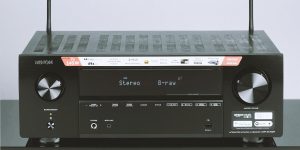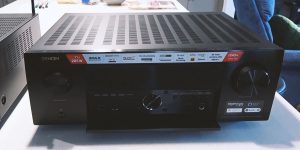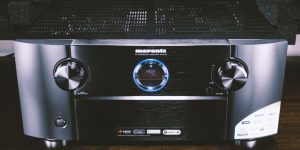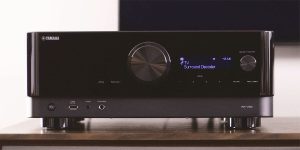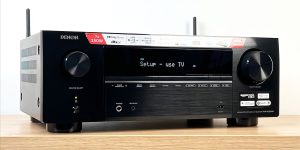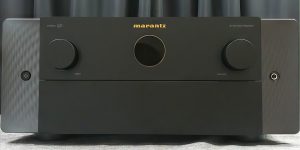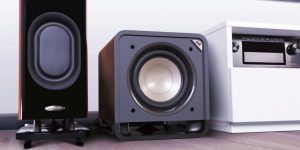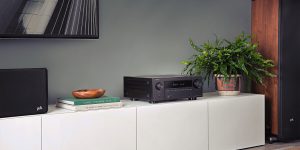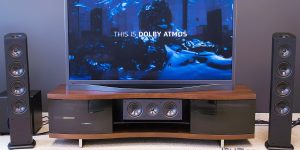Do you want to buy a receiver that will allow you to diversify your leisure time as much as possible in a big house? If so, you are in the right place! I have prepared the best 2 zone receivers that will allow you to enjoy various content in different rooms without paying an insane price. Today, this feature is no longer part of premium audio systems and is available to many users.
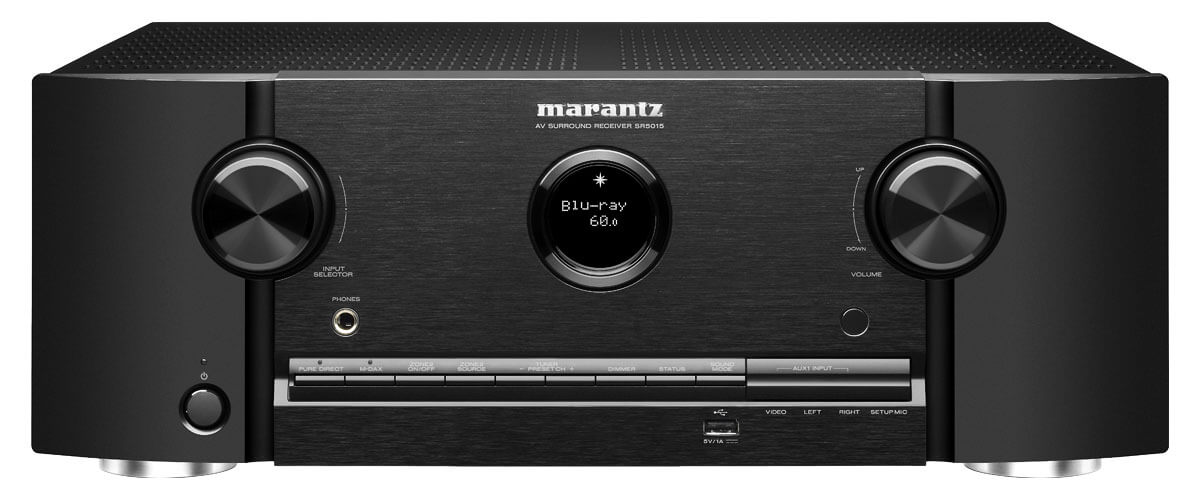
But let’s first understand how a dual zone receiver works, and then I’ll share my experience with tested devices and their ability to control the multi-room function.
Two-zone receiver comparison table
| Name | Channels | Power output | HDMI in/out | Bluetooth/Wi-Fi | Review |
|---|---|---|---|---|---|
| Marantz SR5015 best overall | 7.2 | 100W/8 Ohm, 140W/6 Ohm | 6/2 | yes/yes | Review |
| Denon AVR-X1700H budget | 7.2 | 80W/8 Ohm, 120W/6 Ohm | 6/1 | yes/yes | Review |
| Yamaha RX-A2A | 7.2 | 100W/8 Ohm | 7/1 | yes/yes | Review |
| Pioneer Elite VSX-LX105 | 9.2 | 100W/8 Ohm, 210W/6 Ohm | 6/2 | yes/yes | Review |
How does 2 zone receiver work?
The receiver first gets the signal by cable from various sources, splits it, and finally sends it to the rooms you want (for example, devices that are connected to the AV receiver via zone 1 and zone 2.)
You need at least a two-zone receiver to implement the multi-room function. Since all devices in this review have 7 channels of sound distribution, the easiest way is to launch the receiver in 5-channel mode for the main room. In this case, you are left with two additional channels for the speakers connected to Zone 2.
Best 2 zone receiver reviews
Marantz SR5015 – best overall
Marantz is a well-known company that pays tremendous attention to tuned sound. They have become popular because they don't like to compromise quality for their price. Therefore, when users buy Marantz products, they can expect to have a quality product that adheres to Marantz's classic sound. My today's Marantz SR5015 review aims to check whether its mid-range product adheres to those traditional quality and sound peculiarities and to determine its place in this price segment among the models of other manufacturers.
Design

Is there a way to improve perfection? Perhaps, but not in this case. The Marantz SR5015 is a timeless classic - a black box with two large control surfaces on the left, control buttons in the center, and a screen in the middle. Though, one of the competitors, Denon AVR-X2700H, has a more readable screen. The device measures 17.3 x 9.1 x 13.7 inches and weighs slightly over 22 pounds.
Altogether, it is a well-made AV receiver that, in terms of design, sticks to Marantz traditions but has no distinctive features that make it stand out from the line of other, figuratively speaking, black boxes with minor differences from one another.
Features and specs
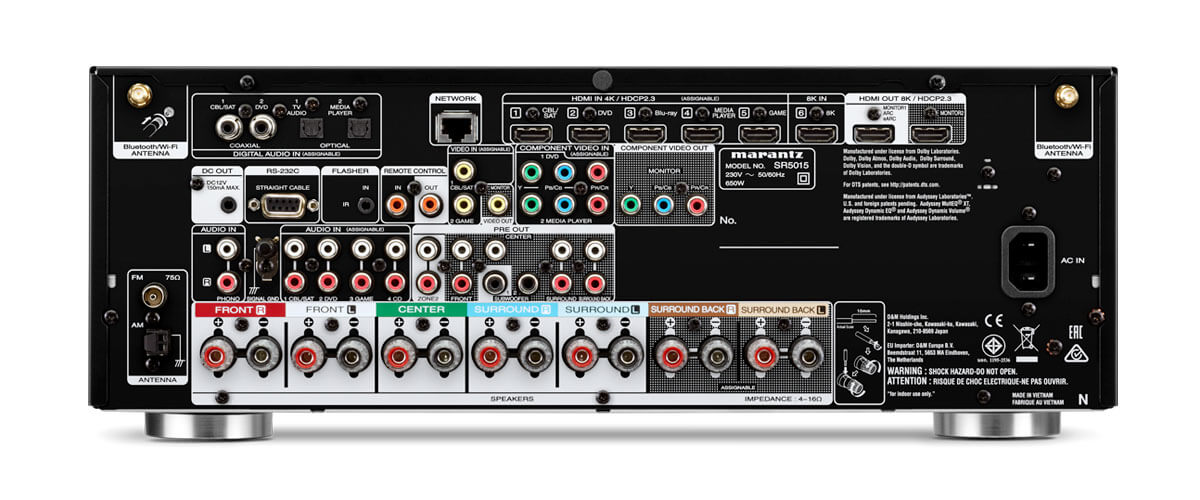
According to the SR5015 specifications, a 7.2 channel receiver provides 100W per channel using 8 Ohm speakers 20Hz-20kHz and 0.08% THD. An interesting aspect is that Marantz's proprietary energy-saving technology automatically adapts the receiver to a wide range of speakers. It also shows stable performance with 4 Ohm speakers, which is pretty unusual for this class of AV receivers.
The receiver supports the latest audio technologies, including Dolby Atmos, Dolby Atmos Height Virtualization Technology, DTS:X, and DTS Virtual:X processing. The set is pretty impressive, isn't it?
Typically, for this price range, the SR5015 supports Zone 2 features. It is also quite common, and even the more expensive models of different brands mainly provide support for only 2 zones.
The model supports 6 HDMI (HDCP 2.3) inputs, but only one of those supports 8k60Hz (but the cheaper Denon AVR-X1700H supports 3 HDMI 8k60Hz). The SR5015 supports two HDMI outputs, 2 (1 front) composite, 2 component inputs, single USB(a) on the front, and single composite and component outputs, 6.3 mm headphones output. In addition, the model supports Ethernet, Wi-Fi, Bluetooth, HEOS-compatible speakers, and all modern streaming services. No frills, but there is everything you need.
Marantz SR5015 features HDR10+ and older, HLG, Dolby Vision, and Dynamic HDR. It shows pleasant video quality, brightness, clarity, and contrast control. Typically, for the price range, the receiver supports 8K upscaling. It meets all modern requirements, and you will have no problems watching any format and video quality.
Listening experience
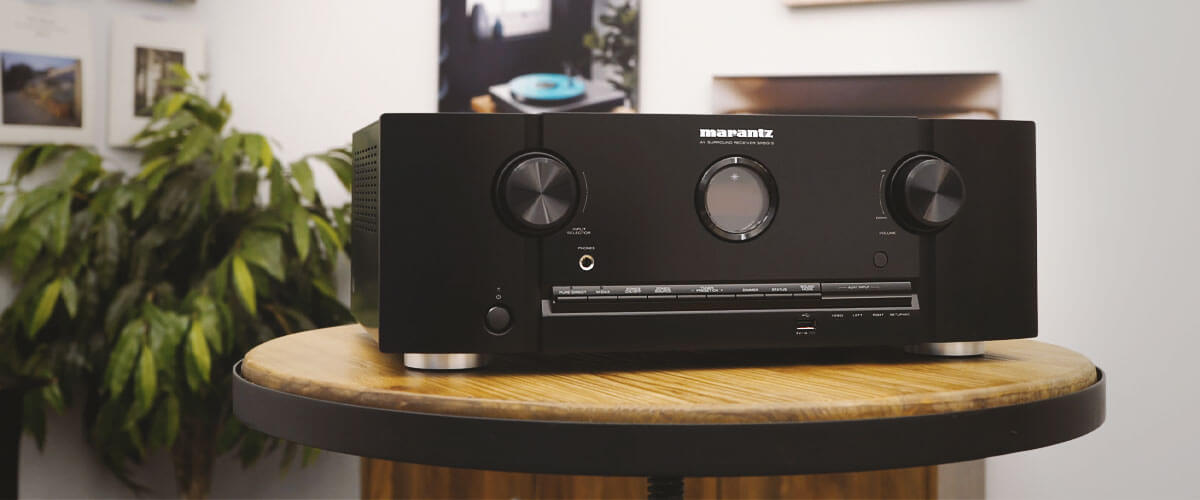
As you would expect from any Marantz AV receiver, the new SR5015 pays special attention to sound quality. When watching movies, it delivers an immersive and richly detailed surround sound experience. Due to its proprietary current feedback topology and definition of HDAM, the SR5015 has the power to fill pretty large rooms with immersive sound and does it surprisingly well. It may even be compared to more expensive models from competitors, such as the Denon AVR-X3700H. And it may even surpass it in dialogue correction.
The unit's performance in music may not match the so-called audiophile quality standard, but it still offers pretty impressive lower frequencies while maintaining clear heights. I often stick to listening to music with classic compressed audio in MP3. The SR5015 also pleasantly surprised me with proprietary Marantz MDAX2 technology that boosts the quality of songs recorded in compressed audio formats such as MP3 or AAC and takes their quality to a new level. Indeed, it doesn't match the lossless FLAC format, but the difference when using MDAX2 is audible.
Key specs
- Channels: 7.2.
- Power output: 100W/8 Ohm, 140W/6 Ohm.
- HDMI inputs/outputs: 6/2.
- Video functions: 8K/60Hz, 4K/120Hz, 4K/60Hz pass-through, video upconversion (up to 1080p and 8K) for analog and HDMI sources.
- Bluetooth/Wi-Fi: yes/yes.
- Streaming services: AirPlay2, Deezer, Tidal, Pandora, SiriusXM, Napster, SoundCloud, Amazon Music, Amazon Music HD, Mood mix.
- Supports: HDMI ARC, HDMI eARC, HDMI CEC, HDCP2.3, HDR10, HDR10+, Dolby Vision.
- Surround sound: DTS HD Master, DTS Neural:X, Dolby TrueHD, Dolby Surround, Dolby Digital Plus, Dolby Atmos Height Virtualization, Dolby Atmos, Multichannel stereo.
This is my favorite, and I think the Marantz SR5015 is the best 2 zone receiver overall. Among analogs, it clearly stands out for sound quality, reliability, and a really wide range of additional features. In my opinion, it is one of the most successful variants on the market right now.
Denon AVR-X1700H – budget
Given the competitiveness of the modern AV receiver market, Denon had to take a bold step to strike its competitors. From the first glance at AVR-X1700H specifications, I realized that the competition would be fascinating. And I wasn't wrong back then.
The Marantz has a slim but mighty 5.2 channel NR1510 receiver in this price range. In turn, Yamaha doesn't seem to take a backseat with their 5.2 channel RX-V4A. And when the Denon cavalry, the AVR-X1700H, arrived in October 2021, the market already had the AVR-X2700H. Nevertheless, the hero of my review is not the most expensive model among analogs and is cheaper than the X2700H. So now, when some time has passed, I can make a comprehensive Denon AVR-X1700H review to see whether this unit is actually worth all the fuss around.
Design
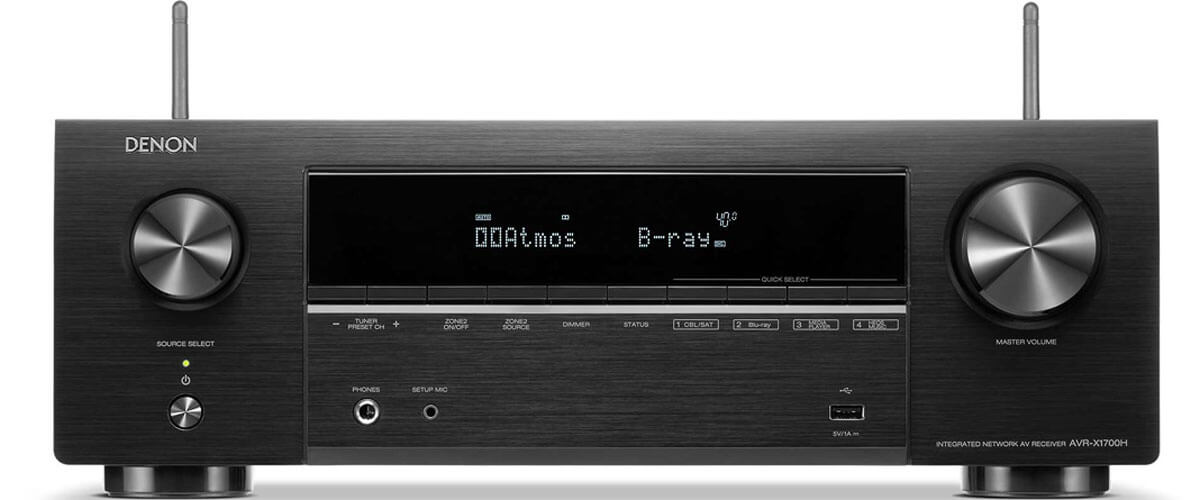
The AVR-X1700H is not a trendsetter when it comes to design. I didn't manage to find much of a change when comparing the X1700H with X2700H. A classic black box with convenient control surfaces and a big readable screen in the middle. Dimensions are also relatively standard for this price range, 17.1× 13.3 × 6 in. The AVR-X1700H weighs slightly less than the AVR-X2700H - 18.96 lbs vs. 21.
After unpacking the receiver and holding it in the hands, it felt solid and rigid, giving a feeling of holding a costly and quality unit. No strange noises or scary crunch sounds that one may have from more simple units. Even though the AVR-X2700H is more expensive, it has the same case and quality. This aspect enormously benefits the AVR-X1700H, as in some cases, more affordable AV receivers have cheaper cases.
Features and specs

Denon AVR-X1700H has the situation firmly in hand by being a 7.2 Ch AV receiver. For comparison, Marantz, in the same price range, offers 5.2 NR1510, and Yamaha also comes with 5.2 channel RX-V4A. Denon also surpasses its competitors in terms of power, offering 80W with 8-ohm speakers, 20 Hz - 20 kHz, 0.08%. It is enough to fill the middle-sized room with immersive sound, especially with the help of supported Audyssey MultEQ XT and DTS:X technology trees.
Denon has an advantage, having 6 HDMI inputs (HDCP 2.3), 3 of which support 8K resolution at 60 Hz. At the same time, as all analogs, Denon AVR-X1700H features include only a single HDMI output. It also contains 2 composite inputs, a single output, 7 speaker terminals, 2 outputs for subwoofers, assignable bi-amping, an FM antenna, has built-in Wi-Fi and Bluetooth. The receiver fully supports Zone 2 feature, which also gives the AVR-X1700H advantage over the NR1510 from Marantz. The latter supports only HEOS-compatible speakers, with no multi-room feature.
In terms of video capabilities, all HDMI support 4K/120Hz, and, as I have mentioned before, only 3 are 8K/60Hz capable. The AVR-X1700H offers almost complete support of the DTS:X technology family, apart from DTS Neo:X. The same goes for the help of the latest Dolby technologies. But in this case, the only exception is Dolby ProLogic II. HDMI to HDMI scaling and HDR 10+. In terms of video features, the receiver stands alongside its competitors without significant flaws or advantages, with specific characteristics that partially equal it to more expensive models.
Listening experience
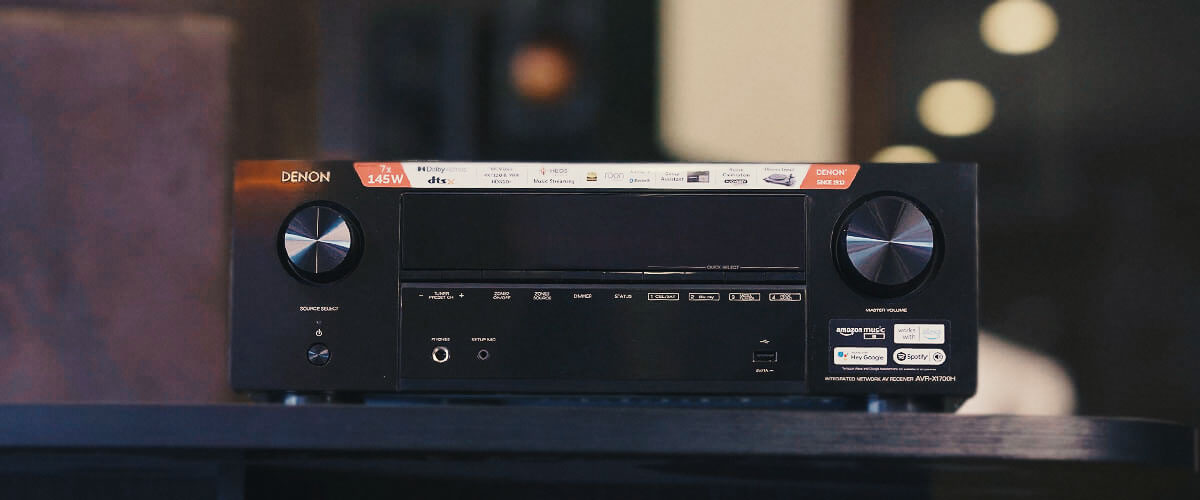
The AVR-X1700H has a pretty pleasant sound when listening to music, showing similar results with a different genre. The level of detail, stability, and vibrato can almost be compared to AVR-X2700H. Compare these two blindfolded, and you won't find much difference in music. With movies, The AVR-X1700H shows detailed, steered, balanced sound. Despite not having the highest power, it delivers just enough to fill a medium-sized room with immersive sound. Two subwoofers work great, delivering theater-like sound.
Denon habitually plays one of the leading companies in the AV receiver industry. Their AVR-X1700H adhered to the company's tradition and didn't disappoint me during the test. It is a severe competitor of Marantz and Yamaha and an excellent choice for optimizing your multimedia system.
Key specs
- Channels: 7.2.
- Power output: 80W/8 Ohm, 120W/6 Ohm.
- HDMI inputs/outputs: 6/1.
- Video functions: 8K/60Hz, 4K/120Hz, 4K/60Hz pass-through, video upconversion (up to 1080p and 8K) for analog and HDMI sources.
- Bluetooth/Wi-Fi: yes/yes.
- Streaming services: AirPlay2, Deezer, Tidal, Pandora, SiriusXM, Napster, SoundCloud, Amazon Music, Amazon Music HD, Mood mix.
- Supports: HDMI ARC, HDMI eARC, HDMI CEC, HDCP2.3, HDR10, HDR10+, Dolby Vision.
- Surround sound: DTS HD Master, DTS Neural:X, Dolby TrueHD, Dolby Surround, Dolby Digital Plus, Dolby Atmos Height Virtualization, Dolby Atmos, Multichannel stereo.
The Denon AVR-X1700H has fairly quickly won the trust of many people, as evidenced by numerous customer reviews. And I want to say that this is well deserved for the most part. Because even though it is more suitable for undemanding use, the model offers modern features and technology at a relatively low cost.
Yamaha RX-A2A
The receiver plays a crucial role in the formation of a complete home theater. Many well-known brands release these devices on the market, but Yamaha has been one of the real leaders in the industry for many years. With these considerations in mind, I have prepared a Yamaha RX-A2A review for you today. The model was released in 2020, belonging to Yamaha's premium Aventage lineup. It is now the most affordable version of this series, combining optimal performance for most of your needs and a reasonable price.
Design
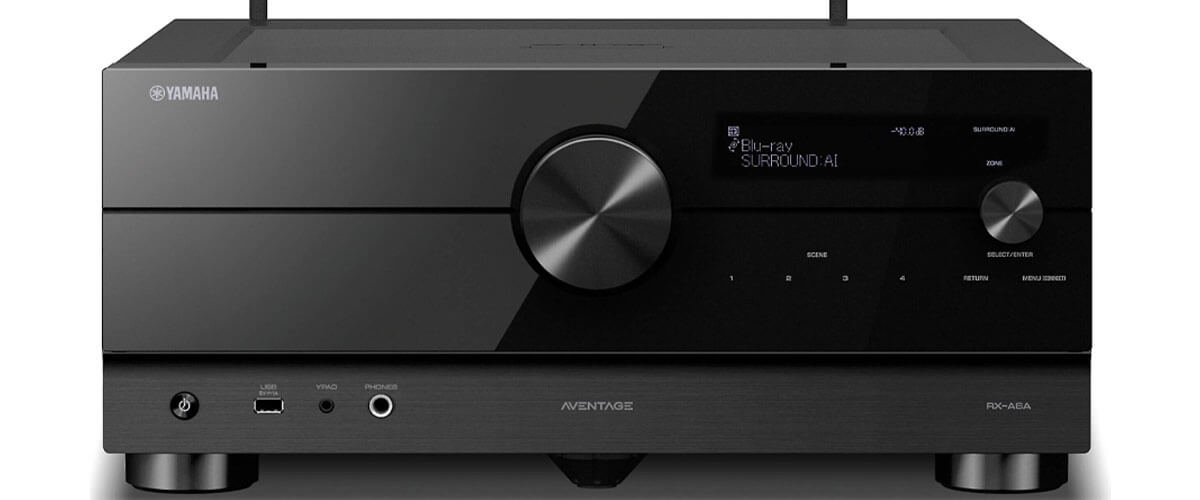
Yamaha has always distinguished itself from competitors through the elaborate design of its products. And the RX-A2A was no exception. The minimalistic design and the glossy black front panel of the device, on which there is a large volume knob in the middle, certainly draw attention.
To the right of the volume control, you will find 4 shortcut buttons. The power button, ports for the microphone, and headphones with 3.5 mm / 6.5 mm connectors are on the opposite side of the receiver, respectively. An excellent engineering solution is using a fifth leg in the center of the chassis model base, damping any vibrations, which positively affects the overall sound quality.
Features and specs
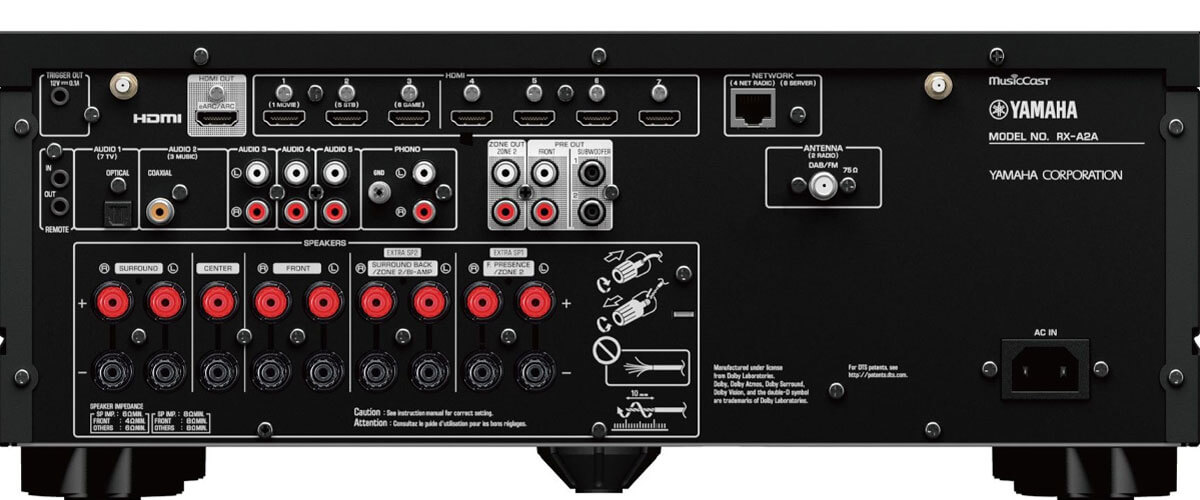
The Yamaha Aventage RX-A2A has a 7.2-channel amplifier with about 100 watts per channel (8 ohms, 20 Hz - 20 kHz, 0.06% THD). Since the device is the cheapest option from the premium class, it is equipped with a 384kHz/32-bit BB PCM5102A DAC. Of course, if you consider newer models, they are equipped with even better components. For example, the RX-A4A already has the latest Qualcomm QCS407 64-bit processor and Surround:AI.
But let's take a closer look at the RX-A2A specifications. It works with 4K resolution (120Hz), HDR10+, Dolby Vision, and Dolby Surround encodings. As a result, the picture looks quite bright and clear. This model also supports 8K resolution (60Hz) and advanced gaming capabilities. The only nuance to consider is that before you turn the receiver on, you must first activate the video synchronization of the TV. If this is not done, sometimes the sound and video will not be displayed, and the image format will be reduced.
There is also support for surround sound formats, such as DTS:X and Dolby Atmos. So watching movies will definitely take you to the next level.
As for connectors and connections, the receiver has 7 HDMI inputs (2.1) and 1 HDMI output (2.1) with HDCP 2.3 and eARC support. Available connection methods include 2 subwoofer outputs, Wi-Fi, USB inputs, network ports, Bluetooth, and Phono (MM) input.
Yamaha has two multi-room zones. This definitely expands the possibilities of using the receiver.This function allows you to enable playback from different sources in the main and Zone 2.
AirPlay 2 technology was also present in this model, allowing my iPhone to stream video and music to supported screens and speakers. So those who are worried about streaming services may not worry - they are also present here.
Listening experience
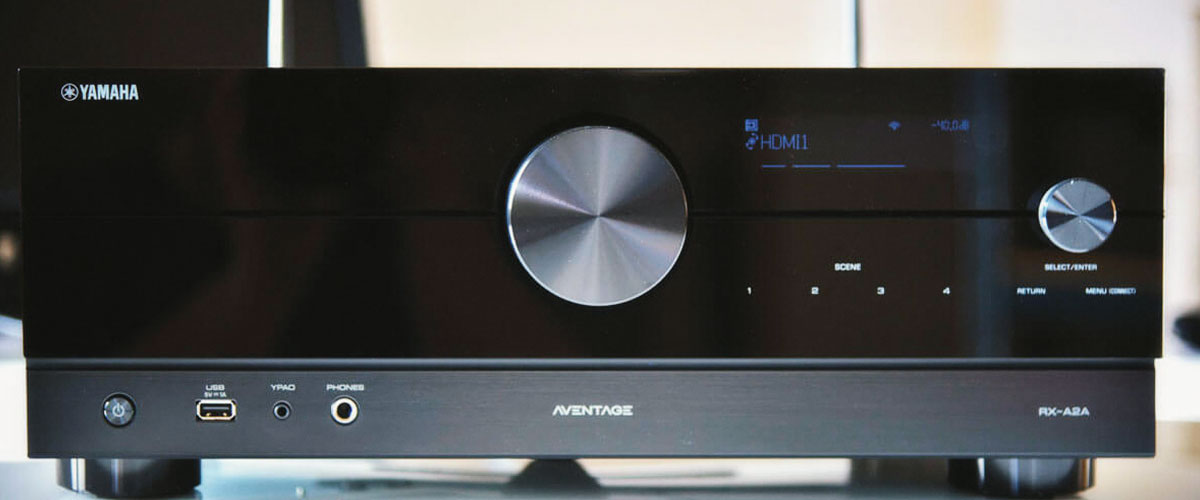
Before using the receiver, I first calibrated the sound with exclusive YPAO technology, and I must say, I achieved excellent results. Watching the movie "Fast and Furious 9" turned out to be quite a thrilling experience. The car chases sounded quite dynamic to me, and the squeals and truck drifts were pleasingly broad and fizzy. Thanks to the presence of surround sound technology, I was able to feel like I was in the middle of the action.
The explosions were less surprising. I'd say they sounded a little rough. As for the rest of the soundstage, it was neatly detailed.
During testing, I faced the problem of delayed sound several times. Namely, "Automatic Lip-sync" did not work correctly. It is hard to say whether this problem is present in all devices of this model or if it was just my "luck."
However, to summarize, I would like to note that the sound did not disappoint me, and although Yamaha RX-A2A is not the leader among the top models, you will definitely be satisfied with the unit for this money.
Key specs
- Channels: 7.2.
- Power output: 100W/8 Ohm.
- HDMI inputs/outputs: 7/1.
- Video functions: 8K/60Hz, 4K/120Hz, 4K/60Hz pass-through, video upconversion (up to 1080p and 4K) for analog and HDMI sources.
- Bluetooth/Wi-Fi: yes/yes.
- Streaming services: AirPlay2, Deezer, Tidal, Pandora, SiriusXM, Napster, SoundCloud, Amazon Music, Amazon Music HD, Mood mix.
- Supports: HDMI ARC, HDMI eARC, HDMI CEC, HDCP2.3, HDR10, HDR10+, Dolby Vision.
- Surround sound: DTS HD Master, DTS Neural:X, Dolby TrueHD, Dolby Surround, Dolby Digital Plus, Dolby Atmos Height Virtualization, Dolby Atmos.
As you know, Yamaha is famous for its sound, and the RX-A2A is no exception. It is really able to satisfy even quite demanding users, not only in terms of sound quality, but also in terms of additional features. All in all, it is a reliable device that will give you many pleasant hours.
Pioneer Elite VSX-LX105
The modern AV receiver is a technological and multifunctional device capable of taking your emotions from watching movies and listening to music to another level. But it is often very difficult to decide which model can meet most of your needs. That's why I've prepared a Pioneer Elite VSX-LX105 review for you today. It is a model from one of the market leaders, which has been delighting fans with good products for many years.
The Japanese company Pioneer made the unit in 2021 as the most affordable premium model, designed exclusively for the American market. The more expensive VSX-LX series receivers are the Elite VSX-LX305 and Elite VSX-LX505.
Design

In terms of design, the VSX-LX105 doesn't differ much from its older brothers. Partly because Pioneer always tries to keep a certain style of its products. The receiver's front panel is not overloaded with various details, so it looks pretty minimalistic.
I liked having a large and well-readable screen in the model's center. There is one knob each on the left and right sides for input selection and volume control. USB and AUX inputs are very conveniently located. As for the power button and Phono input, you will find them in the left corner of the device.
Features and specs

Well, now let's talk about the Pioneer Elite VSX-LX105 features. The receiver has a 7.2-channel amplifier with about 100 watts per channel (8 ohms, 20 Hz-20 kHz, THD 0.08%). In addition to the possibility of using 3 personal presets, it has also been profiled as Roon-Tested, thus guaranteeing perfect compatibility between different devices.
From the technical point of view, the receiver supports 8K resolution at 60Hz, Dolby Vision, and HDR10+ technologies. During image quality testing, I did not notice any malfunctions. The Forrest Gump movie (my favorite classic with lots of talks and action scenes) was played without interruptions or flickers. In general, the picture looked clear, vivid, and moderately contrasted.
Also, a good plus is the presence of two multi-room zones and enhanced gaming. But there is an important nuance here - the 8K pass-through is only available in Zone 1.
Speaking about connectors and methods to connect - everything is also good here. The device has 6 HDMI inputs (2.1) and 2 HDMI outputs (2.1), which are not always found in other models in a similar price range. In addition, the VSX-LX105 supports HDCP 2.3 and eARC technology. Furthermore, there are 2 subwoofer outputs, Ethernet ports, dual-band Wi-Fi, Bluetooth 4.2, and Phono (MM) In, among the available connection methods.
Now, as for the audio specifications of the Elite VSX-LX105. It supports surround sound formats such as Dolby Atmos and DTS:X. Thanks to Dolby Atmos Height Virtualization technology, it is also possible to create a virtual surround effect without additional overhead speakers. But most interestingly, the receiver is certified to work specifically with the Sonos ecosystem. So if you have a Sonos home audio system, you'll like the Sonos Port.
Listening experience
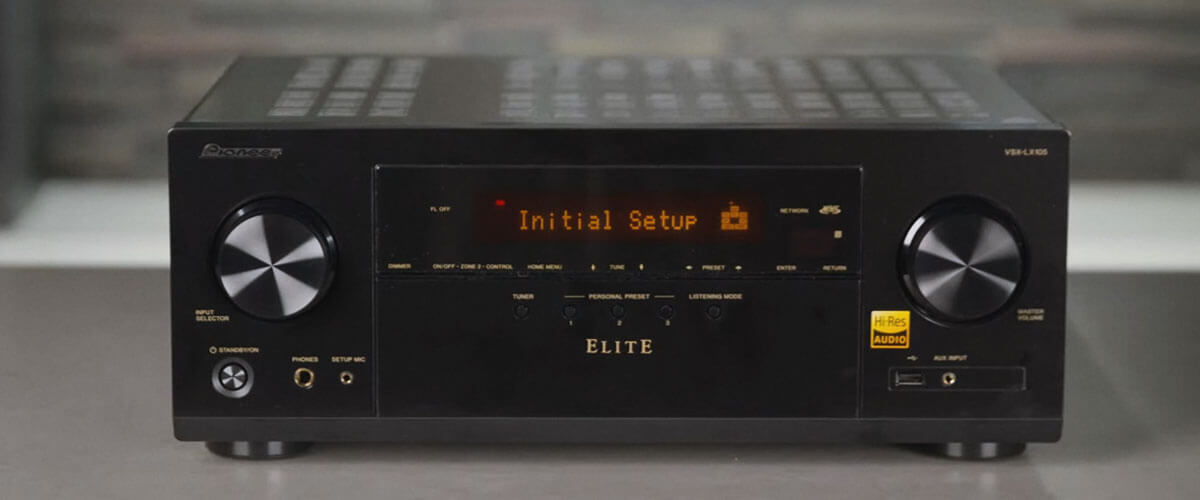
I calibrated the sound from the beginning with MCACC automatic room tuning technology. The sound was pretty easy to set up, so I don't think you'll have any problems with that. The test was conducted in two ways: I watched Forrest Gump and listened to music using AirPlay 2. In both cases, there was an immersive effect. All the details sounded realistic and, most importantly, clean. Although the distortion did not appear when I turned up the volume, I noticed that the receiver started overheating. That is why I ask you to pay attention to this.
Key specs
- Channels: 9.2.
- Power output: 100W/8 Ohm, 210W/6 Ohm.
- HDMI inputs/outputs: 6/2.
- Video functions: 8K/60Hz, 4K/120Hz, 4K/60Hz pass-through, video upconversion (up to 1080p and 8K) for analog and HDMI sources.
- Bluetooth/Wi-Fi: yes/yes.
- Streaming services: AirPlay2, Deezer, Tidal, Pandora, SiriusXM, Napster, SoundCloud, Amazon Music, Amazon Music HD, Mood mix.
- Supports: HDMI ARC, HDMI eARC, HDMI CEC, HDCP2.3, HDR10, HDR10+, Dolby Vision.
- Surround sound: DTS HD Master, DTS Neural:X, Dolby TrueHD, Dolby Surround, Dolby Digital Plus, Dolby Atmos Height Virtualization, Dolby Atmos.
This 7.2 receiver with zone 2 successfully copes with most of the assigned tasks and suits both small and large rooms. Although the Pioneer Elite VSX-LX105 has some points I didn’t quite like, it is still worth your attention.
FAQ
How to set up zone 2 on receiver?
- To begin, you should press the ZONE 2 button on the home theater receiver remote control. This will allow you to set up the work area you want;
- Next, you need to press “POWER,” turning on the power to ZONE 2. After that, the indicator on the display of the receiver should light up;
- Lastly, you must select the desired input channel source for further playback.
Thus, after performing these simple steps, the audio signal of the source you selected will be output to ZONE 2.
Can the receiver be controlled from Zone 2?
Can you use Zone 2 for the subwoofer?
Can You Play Zone 1 and Zone 2 at the same time?
We are supported by our audience. When you purchase through links on our site, we may earn an affiliate commission at no extra cost to you.
Our newsletter
* We will never send you spam or share your email with third parties

![Best Stereo Receivers [Reviewed and Tested]](https://mediapro-av.com/wp-content/uploads/2024/01/best-stereo-receiver-300x150.jpg)

